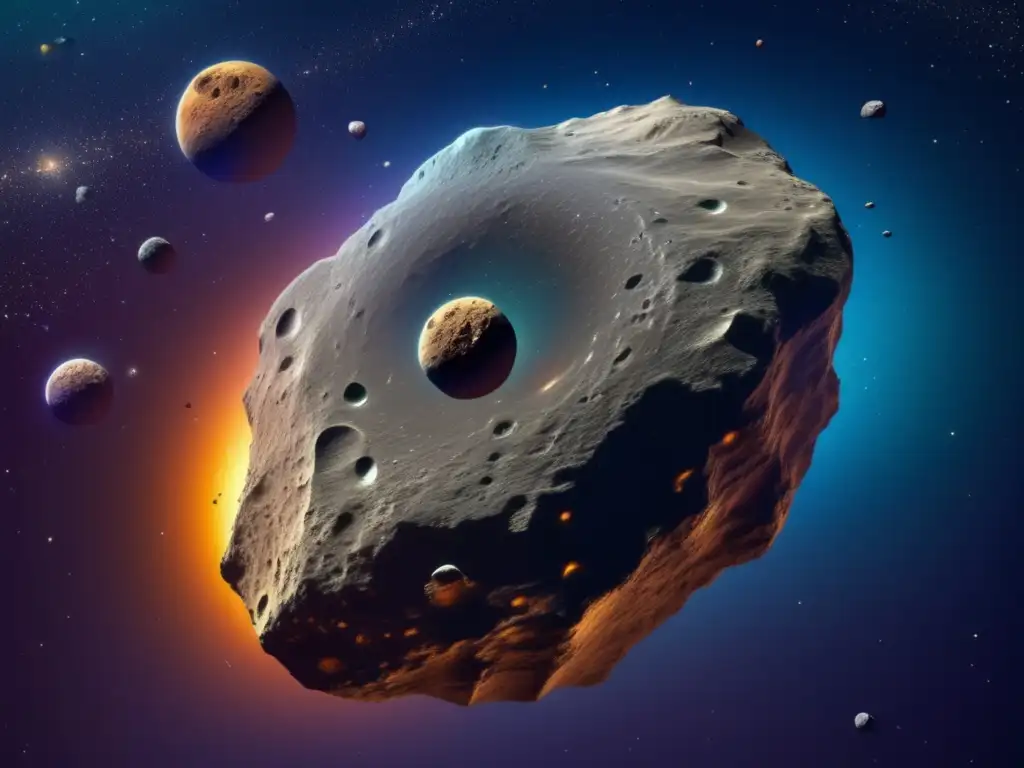Asteroids: Life's Building Blocks In The Cosmos?

Introduction
Asteroids are small, rocky objects that orbit the Sun between Mars and Jupiter in the asteroid belt. They are believed to be leftover debris from the formation of the solar system, and scientists have been studying them for decades to learn more about the origins of the universe. However, recent studies suggest that asteroids may have played a vital role in the emergence of life on Earth and even other planets in the cosmos. In this article, we explore the possibility of asteroids being life's building blocks in the cosmos.
The Chemical Composition of Asteroids

The Presence of Organic Compounds
Asteroids are not just made of rocks and metals; they also contain a variety of organic compounds such as amino acids, nucleobases, and sugars. These compounds are essential building blocks of life and are often found in carbonaceous chondrite meteorites, which are believed to be remnants of primitive asteroids.
The Water Content of Asteroids
Water is another crucial ingredient for life, and asteroids have shown to contain significant amounts of it. Studies have found that some asteroids have water contents of up to 20%, and they are believed to have brought water to Earth during the Late Heavy Bombardment period, a time when asteroids bombarded the inner solar system around 4 billion years ago.
The Role of Asteroids in Planetary Evolution
Asteroids have been implicated in the evolution of planets because they provide building materials that planets use to grow. During planetary formation, asteroids collided with each other, creating larger and more massive objects. Moreover, the impact of asteroids on planets can eject material into space, potentially carrying life forms to other parts of the solar system or even other planetary systems.
Asteroids and the Emergence of Life

The Panspermia Hypothesis
Panspermia is a hypothesis that suggests that life on Earth could have originated from extraterrestrial sources such as asteroids, comets, or meteorites. According to this theory, life forms could have hitchhiked on these objects and survived the harsh space environment until they reached a suitable planet with conducive conditions for life. This theory gains credibility because of the discovery of organic compounds and water on asteroids and the fact that some microbes have shown to survive in space for extended periods.
The Miller-Urey Experiment
The Miller-Urey experiment was an experiment conducted in 1952 to simulate the conditions of early Earth and test the origin of life. The experiment produced amino acids, which are essential building blocks of life. However, subsequent studies showed that the original experiment did not accurately reflect the conditions of early Earth. Recently, scientists have replicated the experiment using conditions similar to those found on asteroids and found that it produces many more organic compounds than previously thought.
The Role of Asteroids in the Diversity of Life
Asteroids could have played a crucial role in the diversity of life on Earth. The Late Heavy Bombardment period that brought water to Earth could also have brought organic compounds that contributed to the emergence of life. Moreover, the impact of asteroids on planets can create environmental niches that allow life to thrive in unexpected ways. For example, the impact of the asteroid that caused the extinction of the dinosaurs created conditions that allowed mammals to diversify and eventually dominate the planet.
Future Exploration of Asteroids for Signs of Life

The Hera Mission
The Hera mission is a European Space Agency mission scheduled to launch in 2024 to study the asteroid system, Didymos. The mission aims to test how effective it is to change the trajectory of an asteroid by crashing a spacecraft into it. Moreover, the mission will study the asteroid's composition, structure, and morphology to gather more information on the origin and evolution of the solar system.
The OSIRIS-REx Mission
The OSIRIS-REx mission is a NASA mission to study the asteroid Bennu. The mission aims to collect a sample of the asteroid's surface and return it to Earth for analysis. Moreover, the mission will study the asteroid's composition, structure, and morphology to gather more information on the origin and evolution of the solar system.
The Potential for Discovering Extraterrestrial Life
Although the primary goal of these missions is not to search for signs of life, they could nevertheless find indications of past or present life on asteroids. Some scientists believe that asteroids could have acted as incubators for life because their small size allows for more substantial temperature fluctuations that could trigger chemical reactions. Moreover, some asteroids have been shown to have underground oceans, which could harbor life forms.
Frequently Asked Questions

-
Can asteroids sustain life?
Asteroids cannot sustain life as we know it because they lack the necessary conditions such as atmospheric pressure, gravity, and radiation protection. However, they can carry life forms and organic compounds that are essential building blocks of life.
-
How do asteroids contribute to the emergence of life?
Asteroids contribute to the emergence of life by providing building blocks such as organic compounds and water that planets use to grow. Moreover, asteroids could have carried life forms to other parts of the solar system or even other planetary systems.
-
Can asteroids pose a threat to life on Earth?
Asteroids can pose a threat to life on Earth if they collide with our planet. However, such events are rare and usually result in minor damage. Nevertheless, scientists continue to study asteroids to understand their behavior and mitigate the risk of a catastrophic impact.
-
What is panspermia?
Panspermia is a hypothesis that suggests that life on Earth could have originated from extraterrestrial sources such as asteroids, comets, or meteorites.
-
How do scientists study asteroids?
Scientists study asteroids through space missions, remote sensing, and ground-based observations. Space missions such as the Hera and OSIRIS-REx missions aim to study asteroids up close and bring back samples for analysis.
Conclusion
Asteroids offer valuable insights into the origin and evolution of the universe, and recent discoveries suggest that they could also have played a crucial role in the emergence and diversity of life. The chemical composition of asteroids, their water content, and their impact on planetary evolution all provide evidence of the potential for life's building blocks in the cosmos. Future space missions and studies will only continue to deepen our understanding of the role of asteroids in the history of life.
Thank you for taking the time to read this article. We encourage you to share your thoughts on the topic in the comments section, and please consider subscribing to www.asteroidrealm.com for more asteroid-related content.
Additional Resources

If you're interested in learning more about asteroids and their role in the cosmos, check out the resources below:
 Interstellar Travelers: How Asteroids Could Transport Life
Interstellar Travelers: How Asteroids Could Transport Life Astrobiology And Asteroids: The Search For Extraterrestrial Life
Astrobiology And Asteroids: The Search For Extraterrestrial Life Life From The Heavens: Asteroids And The Origins Of Life
Life From The Heavens: Asteroids And The Origins Of LifeIf you want to discover more articles similar to Asteroids: Life's Building Blocks In The Cosmos?, you can visit the Asteroids and Extraterrestrial Life category.
Leave a Reply

Articulos relacionados: